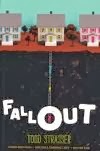In 1979 my first YA novel, Angel
Dust Blues, was published to good reviews. I managed to follow up through the
early 1980s with more well-received novels, but like most careers that get off
to a good start, mine was bound to hit a pot hole sooner or later. And so not
surprisingly, toward the end of the decade I sank into a rut with books that neither
sold well nor received particularly good reviews.
As a result, invitations to speak at
major conferences started to slow, along with interview requests, bookstore
signings, etc. I began to fret that readers, and my publisher, might be tempted
to assume that my best work was behind me.
Worried about my future as a writer,
I resolved to stage a comeback, and worked extra hard to create three new
proposals for timely, cutting-edge, hard-hitting YAs that, I believed, were
sure to be praise-worthy, money-making award winners. My strategy was simple:
if I pitched three, my editor would feel compelled to approve at least one of
them.
When the Day of Judgment arrived, I
clomped into my editor’s office armed with engaging plot summaries and detailed
outlines. I pitched the three book ideas passionately, describing key scenes
and plot points, surprise twists, and unexpectedly satisfying conclusions.
Having put everything I could into
this effort, I ended by telling my editor how eager I was to begin work on at
least two of the books immediately.
Finally, the moment of truth
arrived. He leaned forward, looked me straight in the eye and said, “Todd, I
think you should write some books about dogs.”
Huh?
Once again, the office became still while I struggled to understand the meaning of these words. Was it some kind of joke? If so, I couldn’t see the humor, nor the connection to the important, history-of-YA literature-changing books I’d just pitched.
Once again, the office became still while I struggled to understand the meaning of these words. Was it some kind of joke? If so, I couldn’t see the humor, nor the connection to the important, history-of-YA literature-changing books I’d just pitched.
Meanwhile, my editor waited for my
reply. In retrospect I probably should have asked him what had prompted his
suggestion, but I think I was simply too surprised to think straight. I’d never
owned a dog, had hardly spent any time with them, and had never said or written
anything that might have implied that writing about them would be an interest
of mine.
Then … could this have been some veiled
way of suggesting that perhaps it was time for me to pursue a new career? Or at
the very least, a new publishing company?
Not long after that editorial meeting, my daughter, Lia, was born. If her first words were not, “Can I have a dog?” then they followed very soon. We were living in New York City at the time and pets weren’t allowed in our building, so we gave her Gund dogs and promised that we would get her a real dog as soon as we “moved to the country.”
Several years passed, Lia seemed
content with her Gund dogs, and, to be honest, I forgot all about that promise.
Then we moved to the suburbs. No sooner had we settled into our new home than Lia reminded us of our promise, and kept on reminding us regularly. It wasn’t long before we added an adorable, pudgy yellow lab puppy to the family. His name was Mac, and we all adored him.
However, having had no experience
living with dogs, there were many things we weren’t quite prepared for. Chief
among them was that within two years adorable little puppy Mac would grow to weigh
75 pounds and be exceptionally strong, muscular Mac. As a result, we learned that
there was only one person in the family physically capable of walking him – me
– and even I had to get an extra-long retractable leash so that when he unexpectedly
took off after a squirrel he didn’t instantly yank my shoulder out of its
socket.
I also learned that when you’re a
dog, love is never conditional. They are the
best creatures on Earth. Perhaps because, as a writer, I was home more than
anyone else in the family, and fed and walked him the most, Mac and I became nearly
inseparable.
You’ve probably figured out what’s
coming next: Mac, under the nom de
guerre, Lance, began to appear regularly in my Help! I’m Trapped in…
series, and even starred in two of them: Help! I’m Trapped in Obedience
School, and Help! I’m Trapped in Obedience School Again. He later resurfaced
in the role of Byte in Y2K-9: The Dog Who Saved the World, and was
scheduled to return yet again in the role of Furry Mason, dog detective, but
sadly that series was not published.
In addition, he auditioned for the
role of Wordsworth in a six-book series about a curmudgeonly,
talking canine who becomes the unlikely savior of a family of eccentrics, but
lost out to our neighbor’s basset hound, who was more suited for the position.




